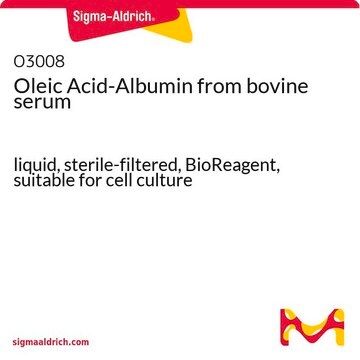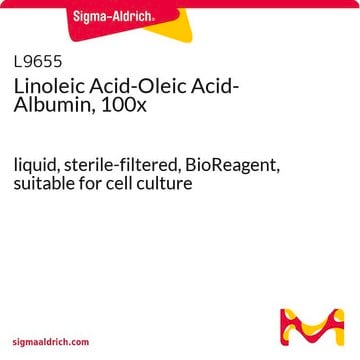This product is a neat or pure liquid and has not been diluted. This material has a density of 0.890 g/mL and a molecular weight of 282.46 g/mol. The minimum purity is 99%, thus the molarity will vary slightly from lot to lot. The molarity can range from 3.12 M (99%) to 3.15 M (100%).
O1383
Acide oléique
BioReagent, suitable for cell culture
Synonyme(s) :
Acide cis-9-octadécènoïque, Acide élaïnique
About This Item
Produits recommandés
Source biologique
palm oil
Niveau de qualité
Pression de vapeur
1 mmHg ( 176 °C)
Gamme de produits
BioReagent
Essai
≥99% (GC)
Forme
viscous liquid
Technique(s)
cell culture | mammalian: suitable
Indice de réfraction
n20/D 1.459 (lit.)
pb
194-195 °C/1.2 mmHg (lit.)
Pf
13-14 °C (lit.)
Solubilité
ethanol: soluble
Densité
0.89 g/mL at 25 °C (lit.)
0.89 g/mL at 25 °C (lit.)
Température de stockage
−20°C
Chaîne SMILES
CCCCCCCC\C=C/CCCCCCCC(O)=O
InChI
1S/C18H34O2/c1-2-3-4-5-6-7-8-9-10-11-12-13-14-15-16-17-18(19)20/h9-10H,2-8,11-17H2,1H3,(H,19,20)/b10-9-
Clé InChI
ZQPPMHVWECSIRJ-KTKRTIGZSA-N
Informations sur le gène
human ... SOAT1(6646) , SOAT2(8435)
Vous recherchez des produits similaires ? Visite Guide de comparaison des produits
Catégories apparentées
Description générale
Application
Conditionnement
Attention
Code de la classe de stockage
10 - Combustible liquids
Classe de danger pour l'eau (WGK)
WGK 1
Équipement de protection individuelle
Eyeshields, Gloves, type ABEK (EN14387) respirator filter
Faites votre choix parmi les versions les plus récentes :
Certificats d'analyse (COA)
Vous ne trouvez pas la bonne version ?
Si vous avez besoin d'une version particulière, vous pouvez rechercher un certificat spécifique par le numéro de lot.
Déjà en possession de ce produit ?
Retrouvez la documentation relative aux produits que vous avez récemment achetés dans la Bibliothèque de documents.
Les clients ont également consulté
Articles
Lipid Induced Insulin Resistance
-
What is the concentration of this oleic acid and what solvent do I need to make dilution
1 réponse-
Utile ?
-
-
What is the concentration of this product-O1383-25G?
1 réponse-
The concentration of this product can be determined using the lot-specific purity reported in the Certificate of Analysis, as well as the density and compound molecular weight. This product has a density of 0.89 g/mL and a molecular weight of 282.46 g/mol. The minimum purity is 99%, thus the molarity will vary slightly from lot to lot. The molarity can range from 3.12 M (99%) to 3.15 M (100%).
Utile ?
-
-
Has product O1383-25g been received in a glass container or ampule?
1 réponse-
Based on the packaging information, product O1383-25g has been received in a glass ampule.
Utile ?
-
Filtres actifs
Notre équipe de scientifiques dispose d'une expérience dans tous les secteurs de la recherche, notamment en sciences de la vie, science des matériaux, synthèse chimique, chromatographie, analyse et dans de nombreux autres domaines..
Contacter notre Service technique








